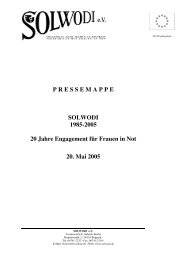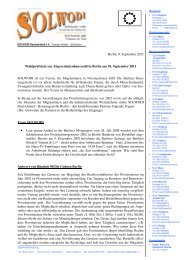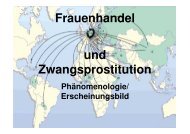Sponsored Vocational Training: Dream of Escape or Reality - Solwodi
Sponsored Vocational Training: Dream of Escape or Reality - Solwodi
Sponsored Vocational Training: Dream of Escape or Reality - Solwodi
You also want an ePaper? Increase the reach of your titles
YUMPU automatically turns print PDFs into web optimized ePapers that Google loves.
Efficacy <strong>of</strong> SOLWODI’s <strong>Vocational</strong> <strong>Training</strong> Scheme 12<br />
would wish to complete and about their personal background. F<strong>or</strong> the 2009 fieldw<strong>or</strong>k a similar<br />
questionnaire was applied in <strong>or</strong>der to guarantee a comparison <strong>of</strong> research findings now versus<br />
the findings three years ago. In 2006 some respondents did not understand certain questions, in<br />
particular the w<strong>or</strong>ding. Hence, during the fieldw<strong>or</strong>k in 2009 some questions were rew<strong>or</strong>ded,<br />
piloted with one key inf<strong>or</strong>mant in the field and a final revision was made to the survey. In 2009,<br />
three types <strong>of</strong> questionnaires depending on the respondent were utilized:<br />
Questionnaire A – f<strong>or</strong> young women who wished to enrol in a <strong>Vocational</strong><br />
<strong>Training</strong>,<br />
Questionnaire B – f<strong>or</strong> trainees who are currently enrolled in a course,<br />
Questionnaire C – f<strong>or</strong> women who have completed their <strong>Vocational</strong> <strong>Training</strong>.<br />
Subsequently, semi-structured, face-to-face, in-depth interviews with a few <strong>of</strong> these<br />
women were conducted. Typically, a semi-structured interview ‘serves as a catalyst to a<br />
comprehensive expression <strong>of</strong> the interviewee’s feelings and beliefs’ (Oakley, 1981: 37). All the<br />
interviews were conducted face-to-face with a set <strong>of</strong> questions, in the f<strong>or</strong>m <strong>of</strong> my questionnaires<br />
at hand, but still allowed f<strong>or</strong> a certain degree <strong>of</strong> freedom. In some interviews notes were taken,<br />
in others, where I specifically set up an appointment with a woman, I was familiar with and<br />
where there was mutual respect, a voice rec<strong>or</strong>der was employed. The voice rec<strong>or</strong>der symbolised<br />
an ‘<strong>of</strong>ficial interview’. Interviews lasted approximately 30 minutes to about one hour and were<br />
mainly conducted on SOLWODI’s premises in private rooms, <strong>or</strong> alternatively in cafés <strong>or</strong><br />
restaurants.<br />
Aspects that might have had a ‘biasing’ effect, but not always did, include: whether the<br />
interview was held on the first meeting. I tried to mitigate this effect by conducting ‘<strong>of</strong>ficial<br />
interviews’ only with those women with whom I had built a relationship. Sometimes the women<br />
did not need any questions; sometimes they were very resentful in their responses. In the latter<br />
case, I tried to reintroduce the topics indirectly. My aim <strong>of</strong> bringing out the voices <strong>of</strong> a marginal<br />
group turned out not to be in the interest <strong>of</strong> the participants. Some interviews tended to be<br />
predominantly run by myself and not by the participants.<br />
One pilot focus group (FG) was arranged only to realise that this is not the way f<strong>or</strong>ward.<br />
FGs are group interaction interviews and are considered to be relatively low in cost due to their<br />
speediness (Bryman, 2004: 345; Krueger, 1988: 44). But, there are limitations: the obtained data<br />
is <strong>of</strong>ten very difficult to analyse. This was realised when I read a transcript <strong>of</strong> my voice






